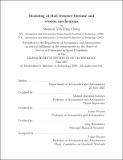| dc.contributor.advisor | Manuel Martinez-Sanchez. | en_US |
| dc.contributor.author | Cheng, Shannon Yun-Ming, 1978- | en_US |
| dc.contributor.other | Massachusetts Institute of Technology. Dept. of Aeronautics and Astronautics. | en_US |
| dc.date.accessioned | 2008-09-02T17:53:40Z | |
| dc.date.available | 2008-09-02T17:53:40Z | |
| dc.date.copyright | 2007 | en_US |
| dc.date.issued | 2007 | en_US |
| dc.identifier.uri | http://hdl.handle.net/1721.1/42043 | |
| dc.description | Thesis (Ph. D.)--Massachusetts Institute of Technology, Dept. of Aeronautics and Astronautics, 2007. | en_US |
| dc.description | This electronic version was submitted by the student author. The certified thesis is available in the Institute Archives and Special Collections. | en_US |
| dc.description | Includes bibliographical references (p. 169-180). | en_US |
| dc.description.abstract | Hall thrusters and other types of electric propulsion have become a tempting alternative to traditional chemical propulsion systems for in-space applications due to the high specific impulses (Isp) they provide. Large Isp translates to a highly desirable mass savings and system trades show that Hall thrusters fall in an optimum operation regime well suited for missions such as station-keeping and orbit transfers. However, uncertainty about thruster lifetime has impeded the device's widespread integration as mission designers want a propulsion system guaranteed to last the entire mission duration. Furthermore, recent interest in applying the technology to more complex propulsion tasks has suggested that throttle-capable thrusters will become desirable and concern about the effect of operating condition on thruster longevity has been raised. To aid in early design stages and later thruster qualification, development of a computational life-prediction tool is needed since experimental lifetime testing is prohibitively expensive and time-consuming. In this work, an axisymmetric hybrid-PIC model, HPHall, has been upgraded to simulate the erosion of the Hall thruster acceleration channel, the degradation of which is the main life-limiting factor of the propulsion system. Evolution of the thruster geometry as a result of material removal due to sputtering is modeled by calculating wall erosion rates, stepping the grid boundary by a chosen time step and altering the computational mesh between simulation runs. The code is first tuned to predict the nose cone erosion of a 200W Busek Hall thruster, the BHT-200. Simulated erosion profiles from the first 500 hours of operation compare favorably to experimental data. | en_US |
| dc.description.abstract | (cont.) The thruster is then subjected to a virtual life test that predicts a lifetime of 1,330 hours, well within the empirically determined range of 1,287-1,519 hours. The model is then applied to the BHT-600, a higher power thruster, to reproduce wear of its exit ring configuration over 932 hours of firing. Better understanding of the physics of anomalous plasma transport and low-energy sputtering are identified as the most pressing needs for improved lifetime models. | en_US |
| dc.description.statementofresponsibility | by Shannon Yun-Ming Cheng. | en_US |
| dc.format.extent | 180 p. | en_US |
| dc.language.iso | eng | en_US |
| dc.publisher | Massachusetts Institute of Technology | en_US |
| dc.rights | M.I.T. theses are protected by
copyright. They may be viewed from this source for any purpose, but
reproduction or distribution in any format is prohibited without written
permission. See provided URL for inquiries about permission. | en_US |
| dc.rights.uri | http://dspace.mit.edu/handle/1721.1/7582 | en_US |
| dc.subject | Aeronautics and Astronautics. | en_US |
| dc.title | Modeling of Hall thruster lifetime and erosion mechanisms | en_US |
| dc.type | Thesis | en_US |
| dc.description.degree | Ph.D. | en_US |
| dc.contributor.department | Massachusetts Institute of Technology. Department of Aeronautics and Astronautics | |
| dc.identifier.oclc | 228865572 | en_US |
